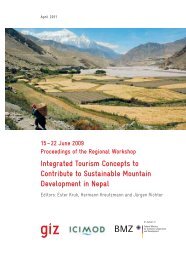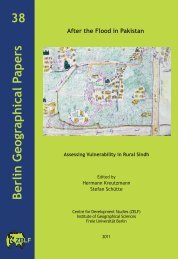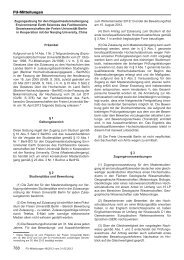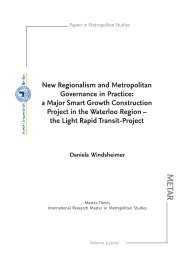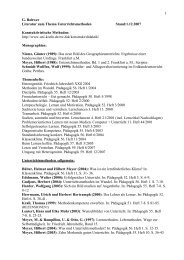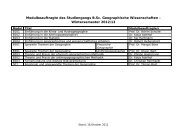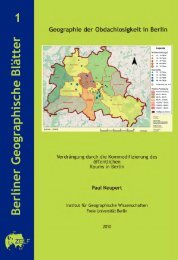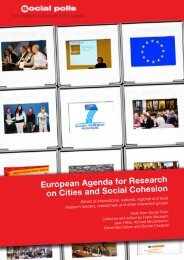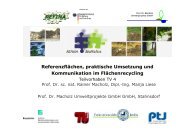Pastoralism and Rangeland Management on the Tibetan Plateau in ...
Pastoralism and Rangeland Management on the Tibetan Plateau in ...
Pastoralism and Rangeland Management on the Tibetan Plateau in ...
Create successful ePaper yourself
Turn your PDF publications into a flip-book with our unique Google optimized e-Paper software.
5 Future Prospects for pastoral Practices <strong>in</strong> <strong>the</strong> Light of envir<strong>on</strong>mental<br />
Protecti<strong>on</strong> <str<strong>on</strong>g>and</str<strong>on</strong>g> Modernity<br />
In Sichuan official statistics have identified that 219,000 out of 533,000 <strong>Tibetan</strong><br />
pastoralists have no permanent settlements <str<strong>on</strong>g>and</str<strong>on</strong>g> that <strong>in</strong> additi<strong>on</strong> 245,000<br />
are liv<strong>in</strong>g <strong>in</strong> “shanty houses”. 47 The “New-Tent-Dwell<strong>in</strong>g Life” project envisages<br />
benefit<strong>in</strong>g those 473,000 pastoralists. A significant amount of funds – about<br />
18 billi<strong>on</strong> Yuan (app. 2.6 billi<strong>on</strong> USD) is allocated by Sichuan Prov<strong>in</strong>ce dur<strong>in</strong>g<br />
2009–2012. The authorities will “c<strong>on</strong>struct 1409 permanent settlements<br />
with<strong>in</strong> a total area of 240,000 km2 (approximately equivalent to <strong>the</strong> area of<br />
<strong>the</strong> United K<strong>in</strong>gdom) <strong>in</strong> 29 pastoral counties”. 48 Probably this new strategy<br />
is unique when it comes to <strong>the</strong> resettlement of people, <strong>the</strong> exclusi<strong>on</strong> of space<br />
from human utilisati<strong>on</strong>, <str<strong>on</strong>g>and</str<strong>on</strong>g> <strong>the</strong> c<strong>on</strong>sequences of this <strong>in</strong>terference. Ab<str<strong>on</strong>g>and</str<strong>on</strong>g><strong>on</strong><strong>in</strong>g<br />
cultural l<str<strong>on</strong>g>and</str<strong>on</strong>g>scapes does not necessarily <strong>in</strong>voke a return to nature. The successi<strong>on</strong><br />
of previously cultivated <str<strong>on</strong>g>and</str<strong>on</strong>g> grazed l<str<strong>on</strong>g>and</str<strong>on</strong>g>s could be an unwelcome set of<br />
vegetati<strong>on</strong> creep<strong>in</strong>g <strong>in</strong>.<br />
The questi<strong>on</strong> rema<strong>in</strong>s: Are <strong>the</strong>re any alternatives for deal<strong>in</strong>g with obvious<br />
degradati<strong>on</strong> <strong>in</strong> certa<strong>in</strong> places <str<strong>on</strong>g>and</str<strong>on</strong>g> with <strong>the</strong> preservati<strong>on</strong> of natural <str<strong>on</strong>g>and</str<strong>on</strong>g> cultural<br />
l<str<strong>on</strong>g>and</str<strong>on</strong>g>scapes? Pastoral strategies have proved over centuries that a resource can be<br />
utilised <strong>in</strong> a susta<strong>in</strong>able manner. If we are c<strong>on</strong>fr<strong>on</strong>ted with a questi<strong>on</strong> of scale<br />
when it comes to envir<strong>on</strong>mental degradati<strong>on</strong> <strong>the</strong>n o<strong>the</strong>r opti<strong>on</strong>s could be useful<br />
tools <strong>in</strong> tackl<strong>in</strong>g <strong>the</strong> challenges <str<strong>on</strong>g>and</str<strong>on</strong>g> c<strong>on</strong>stra<strong>in</strong>ts. The payment for ecological<br />
services could be an attempt to improve <strong>the</strong> liv<strong>in</strong>g c<strong>on</strong>diti<strong>on</strong>s of pastoralists by<br />
leav<strong>in</strong>g <strong>the</strong>m where <strong>the</strong>y are. Payment for ecological services <strong>in</strong>volves <strong>the</strong> reducti<strong>on</strong><br />
of flocks to an acceptable herd size that allows susta<strong>in</strong>able management of<br />
pasture resources. The difference between present high stock<strong>in</strong>g quotas <str<strong>on</strong>g>and</str<strong>on</strong>g><br />
acceptable <strong>on</strong>es would be paid <strong>in</strong> cash to <strong>the</strong> herdsmen by government authorities.<br />
This could amount to about a third of <strong>the</strong> pastoralists’ household <strong>in</strong>come.<br />
49 In view of <strong>the</strong> huge amounts of government <strong>in</strong>vestments that are planned to<br />
be allocated for resettlement schemes it could be a worthwhile c<strong>on</strong>siderati<strong>on</strong><br />
to evaluate <strong>the</strong> advantages of hav<strong>in</strong>g pastoralists as active l<str<strong>on</strong>g>and</str<strong>on</strong>g>scape managers<br />
<strong>in</strong>stead of remov<strong>in</strong>g <strong>the</strong>m <strong>in</strong> great style from pastures that have been utilised for<br />
centuries. The <strong>in</strong>digenous knowledge accumulated by pastoralists over many<br />
generati<strong>on</strong>s seems too valuable to be just neglected or omitted. 50<br />
47 Tao Lu, Wu N<strong>in</strong>g & Peng Luo 2009.<br />
48 Tao Lu, Wu N<strong>in</strong>g & Peng Luo 2009: 1074.<br />
49 In a recent study Wilkes et al. (2010: 64–65) discuss <strong>the</strong> payment for envir<strong>on</strong>mental<br />
services <str<strong>on</strong>g>and</str<strong>on</strong>g> provide an example from H<strong>on</strong>gyuan where <strong>the</strong> difference <strong>in</strong> a household’s<br />
annual <strong>in</strong>come would be app. 6150 Yuan, equivalent to a third of <strong>the</strong> overall <strong>in</strong>come.<br />
50 Cf. Miller (2002) who advocates <strong>the</strong> <strong>in</strong>corporati<strong>on</strong> of pastoralists’ <strong>in</strong>digenous knowledge.<br />
220



